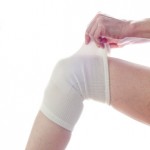 You know that arthritis takes its toll on joints, but do you realize that it also affects structures outside the joints such as ligaments and muscles?
You know that arthritis takes its toll on joints, but do you realize that it also affects structures outside the joints such as ligaments and muscles?
With chronic arthritis comes chronic inflammation and swelling, often when the joint doesn’t even appear swollen from the outside. Increased swelling = increased fluid = increased pressure within the joint = discomfort/pain. While your body can’t stop the inflammation, it can decrease the pressure. It does this by keeping the joint in whatever position maximizes the space within the joint, allowing the extra fluid to be accommodated with the least pressure. It’s like letting out the seams on a tight dress–the volume of the contents is the same, but you’re expanding the container a bit to relieve some of the pressure.
For example, the most comfortable position for a swollen knee is when it’s bent roughly 30 degrees (assuming a straight knee is 0 degrees). So whenever possible, your body will try to keep that knee slightly bent–just enough to create more room inside the joint. Unfortunately, over time, that’s enough to result in a flexion contracture, i.e. a knee that can no longer fully straighten. When a knee bends, the muscles behind it (hamstrings) and the ligaments on either side of it shorten. Kept in that position long enough, they get ‘stuck’ that way. Even subtle contractures can disrupt normal walking mechanics and/or lead to additional knee, hip and back problems. Depending on the severity of the condition, you can often regain full motion with a diligent stretching program, but the most effective course is prevention. With regards to the knee, a joint so commonly affected by arthritis, here are a few things you can do:
- Keep swelling down to a minimum–this can be through icing (routinely or strategically, i.e. when swelling is anticipated such as after long walks or increased activity), anti-inflammatory medications, compressive braces or wrapping, elevation of the joint, and so forth.
- Try to maintain full range of motion as much as possible–this includes avoiding long periods of knee flexion (e.g. keep legs straightened out when watching television and/or when in bed), regular hamstring stretching, quadricep strengthening, spending a few minutes at a time lying on your stomach with your knees just off the edge of the bed. And lest you forget the tried and true “use it or lose it.”…keeping active goes a long way towards maintaining motion (one good way to keep active with arthritis).
TIP: In any condition that causes chronic joint inflammation and swelling (such as arthritis), it’s possible and worthwhile to prevent secondary problems by proactively controlling swelling and maintaining joint range of motion.

4 Comments